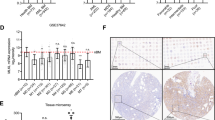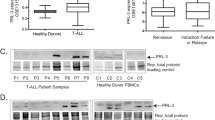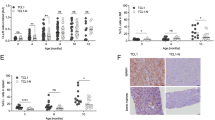Abstract
Chronic myeloid leukemia (CML) is a lethal hematological disorder caused by the p210Bcr−Abl oncogene. Previous studies have suggested that p210Bcr−Abl transformation contributes to homing and retention defects, typical of immature myeloid cells in CML, by attenuating chemotactic response to stromal-derived factor-1α (SDF-1α). As Rho family GTPases are key regulators of the cytoskeleton and have been previously found to interact with p210Bcr−Abl, this study aimed to determine whether p210Bcr−Abl signaling affects SDF-1α chemotaxis through Rho GTPase signaling. We found that SDF-1α stimulated Cdc42 GTPase activation in myeloid progenitor 32D, but not in p210Bcr−Abl-transformed (32Dp210) cells. In fact, the basal level of active Cdc42 was elevated in 32Dp210 cells and mononuclear cells isolated from bone marrow of CML patients. Inhibition of p210Bcr−Abl kinase activity decreased basal Cdc42 activity and restored SDF-1α-induced Cdc42 and migration responses. Transduction of active Tat-Cdc42V12 abolished this reconstituted chemotactic response. As Cdc42 is particularly important in cytoskeletal remodeling and directional sensing, these results suggest that sustained activation of Cdc42 GTPase through p210Bcr−Abl tyrosine kinase signaling in CML cells contributes to defects in SDF-1α-chemotactic response due to desensitization of the actin polarization signal required for directional migration.
This is a preview of subscription content, access via your institution
Access options
Subscribe to this journal
Receive 50 print issues and online access
$259.00 per year
only $5.18 per issue
Buy this article
- Purchase on Springer Link
- Instant access to full article PDF
Prices may be subject to local taxes which are calculated during checkout






Similar content being viewed by others
References
Aghazadeh B, Lowry WE, Huang XY, Rosen MK . (2000). Structural basis for relief of autoinhibition of the Dbl homology domain of proto-oncogene Vav by tyrosine phosphorylation. Cell 102: 625–633.
Bassermann F, Jahn T, Miething C, Seipel P, Bai RY, Coutinho S et al (2002). Association of Bcr-Abl with the proto-oncogene Vav is implicated in activation of the Rac-1 pathway. J Biol Chem 277: 12437–12445.
Burger JA, Burkle A . (2007). The CXCR4 chemokine receptor in acute and chronic leukaemia: a marrow homing receptor and potential therapeutic target. Br J Haematol 137: 288–296.
Chang YC, Lee HH, Chen YJ, Bokoch GM, Chang ZF . (2006). Contribution of guanine exchange factor H1 in phorbol ester-induced apoptosis. Cell Death Differ 13: 2023–2032.
Daley GQ, Van Etten RA, Baltimore D . (1990). Induction of chronic myelogenous leukemia in mice by the P210bcr/abl gene of the Philadelphia chromosome. Science 247: 824–830.
Daubon T, Chasseriau J, Ali AE, Rivet J, Kitzis A, Constantin B et al (2008). Differential motility of p190bcr-abl- and p210bcr-abl-expressing cells: respective roles of Vav and Bcr-Abl GEFs. Oncogene 27: 2673–2685.
Deininger M, Buchdunger E, Druker BJ . (2005). The development of imatinib as a therapeutic agent for chronic myeloid leukemia. Blood 105: 2640–2653.
Deininger MW, Goldman JM, Melo JV . (2000). The molecular biology of chronic myeloid leukemia. Blood 96: 3343–3356.
Geay JF, Buet D, Zhang Y, Foudi A, Jarrier P, Berthebaud M et al (2005). p210BCR-ABL inhibits SDF-1 chemotactic response via alteration of CXCR4 signaling and down-regulation of CXCR4 expression. Cancer Res 65: 2676–2683.
Genth H, Hofmann F, Selzer J, Rex G, Aktories K, Just I . (1996). Difference in protein substrate specificity between hemorrhagic toxin and lethal toxin from Clostridium sordellii. Biochem Biophys Res Commun 229: 370–374.
Gottig S, Mobest D, Ruster B, Grace B, Winter S, Seifried E et al (2006). Role of the monomeric GTPase Rho in hematopoietic progenitor cell migration and transplantation. Eur J Immunol 36: 180–189.
Haddad E, Zugaza JL, Louache F, Debili N, Crouin C, Schwarz K et al (2001). The interaction between Cdc42 and WASP is required for SDF-1-induced T-lymphocyte chemotaxis. Blood 97: 33–38.
Harnois T, Constantin B, Rioux A, Grenioux E, Kitzis A, Bourmeyster N . (2003). Differential interaction and activation of Rho family GTPases by p210bcr–abl and p190bcr–abl. Oncogene 22: 6445–6454.
Hornstein I, Alcover A, Katzav S . (2004). Vav proteins, masters of the world of cytoskeleton organization. Cell Signal 16: 1–11.
Li Z, Hannigan M, Mo Z, Liu B, Lu W, Wu Y et al (2003). Directional sensing requires G beta gamma-mediated PAK1 and PIX alpha-dependent activation of Cdc42. Cell 114: 215–227.
Lopez-Lago M, Lee H, Cruz C, Movilla N, Bustelo XR . (2000). Tyrosine phosphorylation mediates both activation and downmodulation of the biological activity of Vav. Mol Cell Biol 20: 1678–1691.
Macara IG . (2004). Parsing the polarity code. Nat Rev Mol Cell Biol 5: 220–231.
Matsuguchi T, Inhorn RC, Carlesso N, Xu G, Druker B, Griffin JD . (1995). Tyrosine phosphorylation of p95Vav in myeloid cells is regulated by GM-CSF, IL-3 and steel factor and is constitutively increased by p210BCR/ABL. EMBO J 14: 257–265.
Miletic AV, Swat M, Fujikawa K, Swat W . (2003). Cytoskeletal remodeling in lymphocyte activation. Curr Opin Immunol 15: 261–268.
Nagar B, Hantschel O, Young MA, Scheffzek K, Veach D, Bornmann W et al (2003). Structural basis for the autoinhibition of c-Abl tyrosine kinase. Cell 112: 859–871.
Niggli V . (2003). Signaling to migration in neutrophils: importance of localized pathways. Int J Biochem Cell Biol 35: 1619–1638.
Pear WS, Miller JP, Xu L, Pui JC, Soffer B, Quackenbush RC et al (1998). Efficient and rapid induction of a chronic myelogenous leukemia-like myeloproliferative disease in mice receiving P210 bcr/abl-transduced bone marrow. Blood 92: 3780–3792.
Raftopoulou M, Hall A . (2004). Cell migration: Rho GTPases lead the way. Dev Biol 265: 23–32.
Ramaraj P, Singh H, Niu N, Chu S, Holtz M, Yee JK et al (2004). Effect of mutational inactivation of tyrosine kinase activity on BCR/ABL-induced abnormalities in cell growth and adhesion in human hematopoietic progenitors. Cancer Res 64: 5322–5331.
Ren R . (2005). Mechanisms of BCR-ABL in the pathogenesis of chronic myelogenous leukaemia. Nat Rev Cancer 5: 172–183.
Rowley JD . (1990). The Philadelphia chromosome translocation. A paradigm for understanding leukemia. Cancer 65: 2178–2184.
Salesse S, Verfaillie CM . (2002). BCR/ABL: from molecular mechanisms of leukemia induction to treatment of chronic myelogenous leukemia. Oncogene 21: 8547–8559.
Salgia R, Quackenbush E, Lin J, Souchkova N, Sattler M, Ewaniuk DS et al (1999). The BCR/ABL oncogene alters the chemotactic response to stromal-derived factor-1alpha. Blood 94: 4233–4246.
Sawyers CL . (1999). Chronic myeloid leukemia. N Engl J Med 340: 1330–1340.
Stofega M, DerMardirossian C, Bokoch GM . (2006). Affinity-based assay of Rho guanosine triphosphatase activation. Methods Mol Biol 332: 269–279.
Van Haastert PJ, Devreotes PN . (2004). Chemotaxis: signalling the way forward. Nat Rev Mol Cell Biol 5: 626–634.
Vicente-Manzanares M, Cruz-Adalia A, Martin-Cofreces NB, Cabrero JR, Dosil M, Alvarado-Sanchez B et al (2005). Control of lymphocyte shape and the chemotactic response by the GTP exchange factor Vav. Blood 105: 3026–3034.
Vicente-Manzanares M, Sanchez-Madrid F . (2004). Role of the cytoskeleton during leukocyte responses. Nat Rev Immunol 4: 110–122.
Volinsky N, Gantman A, Yablonski D . (2006). A Pak- and Pix-dependent branch of the SDF-1alpha signalling pathway mediates T cell chemotaxis across restrictive barriers. Biochem J 397: 213–222.
Wertheim JA, Miller JP, Xu L, He Y, Pear WS . (2002). The biology of chronic myelogenous leukemia:mouse models and cell adhesion. Oncogene 21: 8612–8628.
Wilkinson B, Koenigsknecht-Talboo J, Grommes C, Lee CY, Landreth G . (2006). Fibrillar beta-amyloid-stimulated intracellular signaling cascades require Vav for induction of respiratory burst and phagocytosis in monocytes and microglia. J Biol Chem 281: 20842–20850.
Acknowledgements
We are grateful to Dr RB Arlinghaus (Department of Molecular Pathology, The University of Texas MD Anderson Cancer Center, Houston, Texas, USA) for providing 32Dp210 and WEHI cells. We thank the staff of the Second Core Lab, Department of Medical Research, National Taiwan University Hospital for technical support during this study. This study is supported by grant NSC 96-3112-B-002-006 and NSC 97-3112-B-002-026 from the National Science Council, Taiwan.
Author information
Authors and Affiliations
Corresponding author
Additional information
Supplementary Information accompanies the paper on the Oncogene website (http://www.nature.com/onc)
Rights and permissions
About this article
Cite this article
Chang, YC., Tien, SC., Tien, HF. et al. p210Bcr−Abl desensitizes Cdc42 GTPase signaling for SDF-1α-directed migration in chronic myeloid leukemia cells. Oncogene 28, 4105–4115 (2009). https://doi.org/10.1038/onc.2009.260
Received:
Revised:
Accepted:
Published:
Issue Date:
DOI: https://doi.org/10.1038/onc.2009.260
Keywords
This article is cited by
-
Are Molecules Involved in Neuritogenesis and Axon Guidance Related to Autism Pathogenesis?
NeuroMolecular Medicine (2015)
-
STAP-2 interacts with and modulates BCR-ABL-mediated tumorigenesis
Oncogene (2012)



